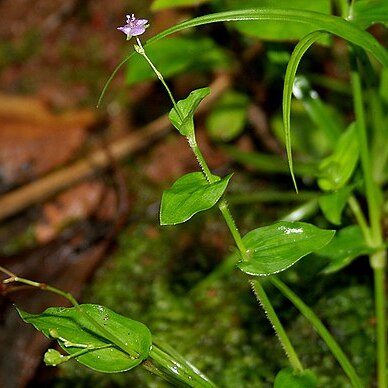Herbs perennial. Roots fibrous. Rhizomes horizontal, elongate, 1--1.5 mm in diam., with sheaths at nodes; internodes to 4 cm, densely yellow hirsute in a line. Stems slender, as thick as rhizomes, creeping proximally, ascending distally, simple or branched, to 35 cm; internodes 1.5--4.5 cm, densely hirsute in a line. Leaf sheaths ca. 5 mm, densely hirsute in a line along mouth slit; leaf blade narrowly ovate to lanceolate, 1.5--3.5 × 0.5--1 cm, glabrous on both surfaces, base truncate, slightly clasping, margin undulate, apex obtuse or acute. Cincinni 1--4, forming terminal panicles, glabrous throughout; peduncle with an infertile, membranous involucral bract above middle; apical involucral bract sheathlike, proximal 1 or 2 involucral bracts similar to leaves in shape, membranous, if only 2 cincinni present then involucral bracts usually absent, if only 1 cincinnus present then cincinni filiform, to 7 cm; bracts very small; pedicels elongate, to 7 mm in fruit. Sepals elliptic, 3--4 mm, persistent. Petals pale blue or nearly white, obovate-orbicular. Fertile stamens 3; filaments lanate; staminodes 3; antherodes 3-sect. Capsule oblong, trigonous, 3--4 mm (excluding apiculus), obtuse at both ends, apiculate at apex. Seeds 3--7 per valve, uniseriate, gray-white, verrucose. Fl. Jan--Dec. 2 n = 40.
More
Herbs, annual, erect to decumbent, usually much branched with age, to 30 cm. Leaves: blade lanceolate-oblong to ovate, 1--4 ´ 0.3--1 cm. Inflorescences: cymes 1--2, several-flowered, elongate; bracteoles persistent, 2--6 mm apart. Flowers bisexual, radially symmetric, 8 mm wide; sepals 2.5--4 mm; petals rose or lavender with darker veins, 4--5 mm; fertile stamens 3; filaments bearded; staminodes 3. Capsules 3--5 mm. Seeds 3--7 per locule, less than 1 mm, warty.
A perennial creeping herb. It lies along the ground. The leaves clasp the stem. It has horizontal rhizomes that are 1-2 mm across. The stems are slender. They are 35 cm long. The leaves are 2-4 cm long by 1 cm wide.
A tropical plant. It grows in forests, humid wastelands, sandy places by streams from near sea level to 1000 m altitude in southern China. In Yunnan.


